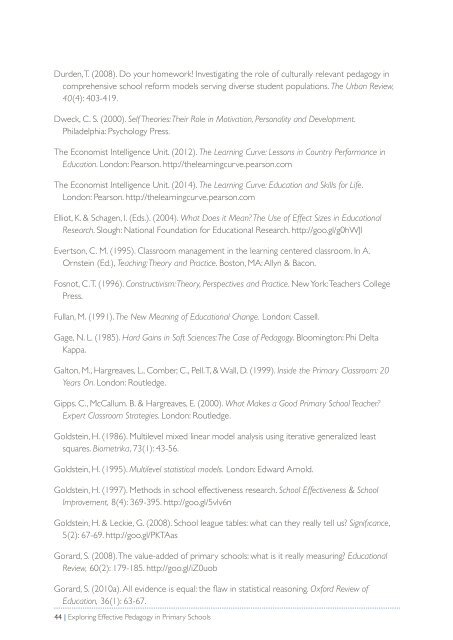Durden, T. (2008). Do your homework! Investigat<strong>in</strong>g the role of culturally relevant pedagogy <strong>in</strong>comprehensive school reform models serv<strong>in</strong>g diverse student populations. The Urban Review,40(4): 403-419.Dweck, C. S. (2000). Self Theories: Their Role <strong>in</strong> Motivation, Personality and Development.Philadelphia: Psychology Press.The Economist Intelligence Unit. (2012). The Learn<strong>in</strong>g Curve: Lessons <strong>in</strong> Country Performance <strong>in</strong>Education. London: <strong>Pearson</strong>. http://thelearn<strong>in</strong>gcurve.pearson.comThe Economist Intelligence Unit. (2014). The Learn<strong>in</strong>g Curve: Education and Skills for Life.London: <strong>Pearson</strong>. http://thelearn<strong>in</strong>gcurve.pearson.comElliot, K. & Schagen, I. (Eds.). (2004). What Does it Mean? The Use of Effect Sizes <strong>in</strong> EducationalResearch. Slough: National Foundation for Educational Research. http://goo.gl/g0hWJlEvertson, C. M. (1995). Classroom management <strong>in</strong> the learn<strong>in</strong>g centered classroom. In A.Ornste<strong>in</strong> (Ed.), Teach<strong>in</strong>g: Theory and Practice. Boston, MA: Allyn & Bacon.Fosnot, C. T. (1996). Constructivism: Theory, Perspectives and Practice. New York: Teachers CollegePress.Fullan, M. (1991). The New Mean<strong>in</strong>g of Educational Change. London: Cassell.Gage, N. L. (1985). Hard Ga<strong>in</strong>s <strong>in</strong> Soft Sciences: The Case of <strong>Pedagogy</strong>. Bloom<strong>in</strong>gton: Phi DeltaKappa.Galton, M., Hargreaves, L., Comber, C., Pell. T, & Wall, D. (1999). Inside the <strong>Primary</strong> Classroom: 20Years On. London: Routledge.Gipps. C., McCallum. B. & Hargreaves, E. (2000). What Makes a Good <strong>Primary</strong> School Teacher?Expert Classroom Strategies. London: Routledge.Goldste<strong>in</strong>, H. (1986). Multilevel mixed l<strong>in</strong>ear model analysis us<strong>in</strong>g iterative generalized leastsquares. Biometrika, 73(1): 43-56.Goldste<strong>in</strong>, H. (1995). Multilevel statistical models. London: Edward Arnold.Goldste<strong>in</strong>, H. (1997). Methods <strong>in</strong> school effectiveness research. School <strong>Effective</strong>ness & SchoolImprovement, 8(4): 369-395. http://goo.gl/5vlv6nGoldste<strong>in</strong>, H. & Leckie, G. (2008). School league tables: what can they really tell us? Significance,5(2): 67-69. http://goo.gl/PKTAasGorard, S. (2008). The value-added of primary schools: what is it really measur<strong>in</strong>g? EducationalReview, 60(2): 179-185. http://goo.gl/iZ0uobGorard, S. (2010a). All evidence is equal: the flaw <strong>in</strong> statistical reason<strong>in</strong>g. Oxford Review ofEducation, 36(1): 63-67.44 | <strong>Explor<strong>in</strong>g</strong> <strong>Effective</strong> <strong>Pedagogy</strong> <strong>in</strong> <strong>Primary</strong> <strong>Schools</strong>
Gorard, S. (2010b). Serious doubts about school effectiveness. British Educational ResearchJournal, 36(5): 745-766. http://goo.gl/vnlE36Harms, T., Clifford R. M. & Cryer. D. (1998). Early Childhood Environmental Rat<strong>in</strong>g Scale, RevisedEdition (ECERS-R). New York:Teachers College Press.Harris, R., & Ratcliffe, M. (2005). Socio-scientific issues and the quality of exploratory talk – whatcan be learned from schools <strong>in</strong>volved <strong>in</strong> a ‘collapsed day’ project? The Curriculum Journal, 16(4):439-453.Hattie, J. (2012). Visible Learn<strong>in</strong>g for Teachers: Maximiz<strong>in</strong>g impact on learn<strong>in</strong>g. London: Routledge.Henchey, N. (2001). <strong>Schools</strong> that make a difference: F<strong>in</strong>al report. Twelve Canadian secondary schools<strong>in</strong> low <strong>in</strong>come sett<strong>in</strong>gs. Kelowna, BC: Society for the Advancement of Excellence <strong>in</strong> Education.Hill, P. W. & Rowe, K. J. (1996). Multilevel model<strong>in</strong>g <strong>in</strong> school effectiveness research. School<strong>Effective</strong>ness and School Improvement, 7(1): 1-34.Hill, P. & Rowe, K. (1998). Modell<strong>in</strong>g student progress <strong>in</strong> studies of educational effectiveness.School <strong>Effective</strong>ness & School Improvement, 9(3): 310-333.Hopk<strong>in</strong>s, D. (2001). Meet<strong>in</strong>g the challenge: An improvement guide for schools fac<strong>in</strong>g challeng<strong>in</strong>gcircumstances (Report prepared for Department for Education and Employment’s Standards &<strong>Effective</strong>ness Unit). Nott<strong>in</strong>gham: University of Nott<strong>in</strong>gham.James, C. Connolly, M., Dunn<strong>in</strong>g, G. & Elliot, T. (2006). How Very <strong>Effective</strong> <strong>Primary</strong> <strong>Schools</strong> Work.London: Sage.Ko, J. & Sammons, P. with Bakkum (2013). <strong>Effective</strong> Teach<strong>in</strong>g: A Review of Research (Reportcommissioned by CfBT). Oxford: Department of Education. http://goo.gl/KiXyyyKutnick, P. & K<strong>in</strong>gton, A. (2005). Children’s friendships and learn<strong>in</strong>g <strong>in</strong> school: Cognitiveenhancement through social <strong>in</strong>teraction? British Journal of Educational Psychology, 75(4): 521-538. http://goo.gl/Qak95ZLeckie, G. & Goldste<strong>in</strong>, H. (2009). The limitations of us<strong>in</strong>g school league tables to <strong>in</strong>form schoolchoice. Journal of the Royal Statistical Society A, 172: 835-851. http://goo.gl/zAWmijLeckie, G. & Goldste<strong>in</strong>, H. (2011). Understand<strong>in</strong>g uncerta<strong>in</strong>ty <strong>in</strong> school league tables. FiscalStudies, 32: 207-224. http://goo.gl/J3cshrLuyten, H. (1996). Teacher Change and Instability Across Grades. Educational Research andEvaluation, 1(1): 67-89.Luyten, H. (2006, January). Assess<strong>in</strong>g the absolute effect of school<strong>in</strong>g with regression-discont<strong>in</strong>uity.Paper presented to the International Congress for School <strong>Effective</strong>ness and Improvement,Fort Lauderdale, FL.Evidence from Research | 45
- Page 1 and 2:
Exploring Effective Pedagogy inPrim
- Page 3 and 4:
About the AuthorsProfessor Iram Sir
- Page 5 and 6:
ContentsForeword - by Dylan WiliamE
- Page 7 and 8: That is why the Effective Pre-Schoo
- Page 9 and 10: Executive SummaryBackgroundThis pub
- Page 11 and 12: some there was incomplete data; onl
- Page 13 and 14: Personalised teaching and learningT
- Page 15 and 16: 1Pedagogy: TheInternational Perspec
- Page 17 and 18: The work of SER scholars provided p
- Page 19 and 20: The TIMSS study is very clear about
- Page 21 and 22: Given that pedagogy is fundamentall
- Page 23 and 24: The methodsThe EPPSE study is uniqu
- Page 25 and 26: The case studies of practice were c
- Page 27 and 28: The full findings of this associate
- Page 29 and 30: Group C: Poor Schools: Low academic
- Page 31 and 32: The initial analyses of the observe
- Page 33 and 34: • Routines are very efficient - h
- Page 35 and 36: 3. HomeworkThe EPPSE 3-14 study sho
- Page 37 and 38: • Supportive approach with high e
- Page 39 and 40: • Only one very minor disagreemen
- Page 41 and 42: Children in highly effective school
- Page 43 and 44: • Teacher is very aware of childr
- Page 45 and 46: Another example demonstrates clear
- Page 47 and 48: 10. Assessment for Learning (AfL)As
- Page 49 and 50: She was able to offer a little feed
- Page 51 and 52: It is highly likely that good organ
- Page 53 and 54: Also, although the large amounts of
- Page 55 and 56: All of the above could be researche
- Page 57: Claxton, G. & Carr, M. (2004). A Fr
- Page 61 and 62: OECD Organisation for Economic Co-o
- Page 63 and 64: Sammons, P., Sylva, K., Melhuish, E
- Page 65 and 66: Veenam, S., Denessen, E., van den A
- Page 67 and 68: Child social behaviour - Social int
- Page 69 and 70: Appendix 2: Complete List of School
- Page 71 and 72: Appendix 2: Complete List of School


